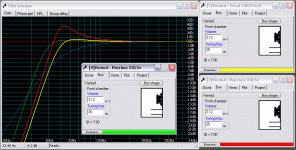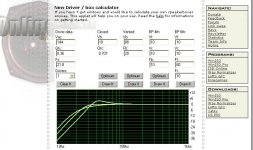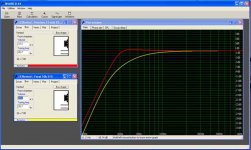I would like to compare sound quality between these two drivers. Has anybody listened to these two drivers or something similar? Is there a way to judge how they are going to sound from the T/S parameters?
I have recently built a 3-way speaker using the 10" Focal's but would like a little more output in the bass region. However, I really like the way the Focal's sound and I don't want to lose the sound quality. They are in bass reflex enclosures with a net volume of 3.12 ft^3 tuned to 35 Hz. They are actively crossed at 100Hz, LR.
I have modeled the Peerless using Winsd Beta and they simulate well in the same enclosure with a little modification to the port. They also will play lower which I like.
Focal's have kevlar cones with rubber surrounds and the following parameters:
Z 10
Re 7.8 ohm
Le 107.64 mH
fs 31.46 Hz
Qms 7.73
Qes 0.367
Qts 0.35
Mms 32 g
Cms 0.0007988 m/N
Sd 360 cm^2
Bl 11.61 N/A
Xmax 5.3 mm
SPL 92
W 175 Watts
Peerless have Nomex cones with rubber surrounds and the followng parameters:
Z 4 ohm
Re 2.5 ohm
Le 1.8 mH
fs 21.8 Hz
Qms 10.24
Qes 0.37
Qts 0.36
Mms 110.9 g
Cms 0.00048 m/N
Sd 466 cm^2
BL 10.2 N/A
Xmax 12.5 mm
SPL 92
W 350 Watts
I have recently built a 3-way speaker using the 10" Focal's but would like a little more output in the bass region. However, I really like the way the Focal's sound and I don't want to lose the sound quality. They are in bass reflex enclosures with a net volume of 3.12 ft^3 tuned to 35 Hz. They are actively crossed at 100Hz, LR.
I have modeled the Peerless using Winsd Beta and they simulate well in the same enclosure with a little modification to the port. They also will play lower which I like.
Focal's have kevlar cones with rubber surrounds and the following parameters:
Z 10
Re 7.8 ohm
Le 107.64 mH
fs 31.46 Hz
Qms 7.73
Qes 0.367
Qts 0.35
Mms 32 g
Cms 0.0007988 m/N
Sd 360 cm^2
Bl 11.61 N/A
Xmax 5.3 mm
SPL 92
W 175 Watts
Peerless have Nomex cones with rubber surrounds and the followng parameters:
Z 4 ohm
Re 2.5 ohm
Le 1.8 mH
fs 21.8 Hz
Qms 10.24
Qes 0.37
Qts 0.36
Mms 110.9 g
Cms 0.00048 m/N
Sd 466 cm^2
BL 10.2 N/A
Xmax 12.5 mm
SPL 92
W 350 Watts
Focal I would try in box of 63 litter (2,33 cu. ft.) and Fb=40-42 Hz.
Peerless is 2 times better unit for low freq. Smaller efficient (about 88 dB with 1 W or 2 V signal, 91 dB with 2 W or 2,83 V signal) but who cares in active system.
It has everything better, magnet, cone, voice-coile. Built like a tenk.
Peerless goes in 68 litter (2,52 cu. ft.) anf Fb=22,5-23,5 Hz.
So, Peerless is my recommendation.
You can use that box. Maybe you can reduce volume some.
And different BR tunel. About Dt=85 mm and Lt=320-350 mm.
Peerless is 2 times better unit for low freq. Smaller efficient (about 88 dB with 1 W or 2 V signal, 91 dB with 2 W or 2,83 V signal) but who cares in active system.
It has everything better, magnet, cone, voice-coile. Built like a tenk.
Peerless goes in 68 litter (2,52 cu. ft.) anf Fb=22,5-23,5 Hz.
So, Peerless is my recommendation.
You can use that box. Maybe you can reduce volume some.
And different BR tunel. About Dt=85 mm and Lt=320-350 mm.
Well, my worst suspicions were correct. The Peerless does not sound as good as the Focal's. I modified only one side so I was able to do a direct comparison with the Peerless on one side and the Focal on the other (the pre-amp set to mono). The Focal seemed to play cleaner in the upper frequencies.
I guess I should let the Peerless break in more since I have only played it for 4 hours. I really doubt that this will help the upper frequencies though.
Any thoughts anybody?
I guess I should let the Peerless break in more since I have only played it for 4 hours. I really doubt that this will help the upper frequencies though.
Any thoughts anybody?
I have heard some larger Focal woofers in bass reflex as well as the XLS with PR subs as well as sealed - 3 different XLS subs at different times. Unfortunately I haven't had an AB comparison.
I do like the sound of Focal woofers. They would have the advantage of more useable top end. The XLS is a great driver and if both are used up to 100 Hz and were eq'd to the same response then I'd expect it would have a chance at sounding as good, but if I had to choose a winner above 40 Hz in SQ then I'd go with the focal.
It's not much of a comparison though, as they are very different drivers. They don't really do the same job.
I do like the sound of Focal woofers. They would have the advantage of more useable top end. The XLS is a great driver and if both are used up to 100 Hz and were eq'd to the same response then I'd expect it would have a chance at sounding as good, but if I had to choose a winner above 40 Hz in SQ then I'd go with the focal.
It's not much of a comparison though, as they are very different drivers. They don't really do the same job.
Hi Nichol1997,
You've just discovered something that DIYers like myself have gradually come to appreciate- it is the design or implementation that is the critical determinant of the end result- ie. how your system sounds.
Your two chosen drivers have a frequency response (~tonal balance) and sensitivity (loudness) that are at opposite ends of the spectrum. Unless you compensate for this in your design, it will be an apples to oranges comparison.
IMHO the improved sound "quality", "richness", or "detail" may be related to higher sensitivity, higher frequency extension, or higher/different non-distortion spectrum.
Your ears are telling you the differences, but without measurements we'll have a hard time figuring out why...
You've just discovered something that DIYers like myself have gradually come to appreciate- it is the design or implementation that is the critical determinant of the end result- ie. how your system sounds.
Your two chosen drivers have a frequency response (~tonal balance) and sensitivity (loudness) that are at opposite ends of the spectrum. Unless you compensate for this in your design, it will be an apples to oranges comparison.
IMHO the improved sound "quality", "richness", or "detail" may be related to higher sensitivity, higher frequency extension, or higher/different non-distortion spectrum.
Your ears are telling you the differences, but without measurements we'll have a hard time figuring out why...
So, is there anyway to make the Peerless sound like the Focals? I thought about the different sensitivities and tried to compensate for this by adjusting the volume but they still sounded different.
The Peerless sounded thicker on the lower octaves but lacked some of the instrument details that I could hear with Focals. I don't want to use a equalizer to try and compensate for this.
How can you predict how a speaker is going to sound? The frequency response supplied by the manufacturer looked good for both drivers.
The Peerless sounded thicker on the lower octaves but lacked some of the instrument details that I could hear with Focals. I don't want to use a equalizer to try and compensate for this.
How can you predict how a speaker is going to sound? The frequency response supplied by the manufacturer looked good for both drivers.
The Peerless will go lower, and the Focal will go higher. They are for different implementations!
For the sake of comparison you could eq them to match to judge SQ. You should play at the same SPL to compare properly.
With the same frequency response they will still sound different, and this is ideally what you want to compare.
The XLS should be happy with 20 - 80 Hz.
I'd use the focal from fs to about 200 or 300 Hz and it will do more than the XLS to improve the rest of the system.
For the sake of comparison you could eq them to match to judge SQ. You should play at the same SPL to compare properly.
With the same frequency response they will still sound different, and this is ideally what you want to compare.
The XLS should be happy with 20 - 80 Hz.
I'd use the focal from fs to about 200 or 300 Hz and it will do more than the XLS to improve the rest of the system.
Everybody keeps saying that I need to eq them before I can directly compare the two drivers. I think I am having trouble understanding just exactly what is happening. I know the Peerless will play lower frequencies and the Focal will play higher frequencies. But, if it is crossed over at 100 Hertz with a slope of 24db per octave, should'nt they both have a flat frequency response between 100 Hertz and say 40 Hertz? I know the room will have an effect but it should have the same effect on both drivers right?
5 minutes simulating will tell you very quickly what is happening.
See image attached
The focal goes down to 35 Hz F3
The XXLS has a nasty hump in that box because it is tuned too high.
For a quick comparison you might be able to stuff the vent - not to block it fully, but to attenuate the peak.
Blue = closed
Red = XXLS in existing vented
Green = tuned lower
To get a comparison you could add some vent on to tune it lower. On some material, the extra depth of the XXLs will be evident, although you will have a better chance to compare midbass differences. Clearly at the moment, the response of the XXLS is dominated by an ugly peak.
See image attached
The focal goes down to 35 Hz F3
The XXLS has a nasty hump in that box because it is tuned too high.
For a quick comparison you might be able to stuff the vent - not to block it fully, but to attenuate the peak.
Blue = closed
Red = XXLS in existing vented
Green = tuned lower
To get a comparison you could add some vent on to tune it lower. On some material, the extra depth of the XXLs will be evident, although you will have a better chance to compare midbass differences. Clearly at the moment, the response of the XXLS is dominated by an ugly peak.
Attachments
See attached graph for 830847 XXLS in 88L box (~3.12 cu ft)
tuning at 35Hz
tuning at 25Hz
tuning at 20Hz.
35Hz tuning is too high, resulting in little low bass.
I would suggest changing the port tuning of the 830847 to 20-25Hz (bottom curve, and 2nd from the bottom, respectively)
tuning at 35Hz
tuning at 25Hz
tuning at 20Hz.
35Hz tuning is too high, resulting in little low bass.
I would suggest changing the port tuning of the 830847 to 20-25Hz (bottom curve, and 2nd from the bottom, respectively)
Attachments
For comparison, you want the drivers to have a similar response. Just temporarily attach extra vent when you put in the XLS so that they have a similar response down to 40 Hz. This will let you compare how they sound with music. You must get rid of that peak to give the XLS a chance. The low tuning is not so good for the focal since the F3 now is too high.
Also include the lowpass in the response, as you will see it changes things considerably - what looks good without a lowpass is not so good when it is included. You must factor in ALL the filters you will be using to get a correct design.
Also include the lowpass in the response, as you will see it changes things considerably - what looks good without a lowpass is not so good when it is included. You must factor in ALL the filters you will be using to get a correct design.
paulspencer said:For comparison, you want the drivers to have a similar response. Just temporarily attach extra vent when you put in the XLS so that they have a similar response down to 40 Hz. This will let you compare how they sound with music. You must get rid of that peak to give the XLS a chance. The low tuning is not so good for the focal since the F3 now is too high.
Also include the lowpass in the response, as you will see it changes things considerably - what looks good without a lowpass is not so good when it is included. You must factor in ALL the filters you will be using to get a correct design.
I am not sure what you mean by including the low pass filter. Are you referring to the 24 db/oct slope with the corner frequency at 100 Hz?
Can WinISD beta do this? I tried to find a way but I don't think it will allow me.
Nichol,
Unless the 2 drivers have the exact same high frequency rolloff, you won't do well using the same same 24dB/octave electrical filter for both.
When you compare crossover topologies, you need to take into account the driver's natural rolloff. That is, you need to compare the acoustic response, which is a combination of the electrical filter's transfer function + driver's natural rolloff.
You are comparing an apple to an orange.
At least get out your textas and paint the orange green.
Unless the 2 drivers have the exact same high frequency rolloff, you won't do well using the same same 24dB/octave electrical filter for both.
When you compare crossover topologies, you need to take into account the driver's natural rolloff. That is, you need to compare the acoustic response, which is a combination of the electrical filter's transfer function + driver's natural rolloff.
You are comparing an apple to an orange.
At least get out your textas and paint the orange green.
- Status
- This old topic is closed. If you want to reopen this topic, contact a moderator using the "Report Post" button.
- Home
- Loudspeakers
- Subwoofers
- Focal 10K 515 vs. Peerless 830847 xxls 12


